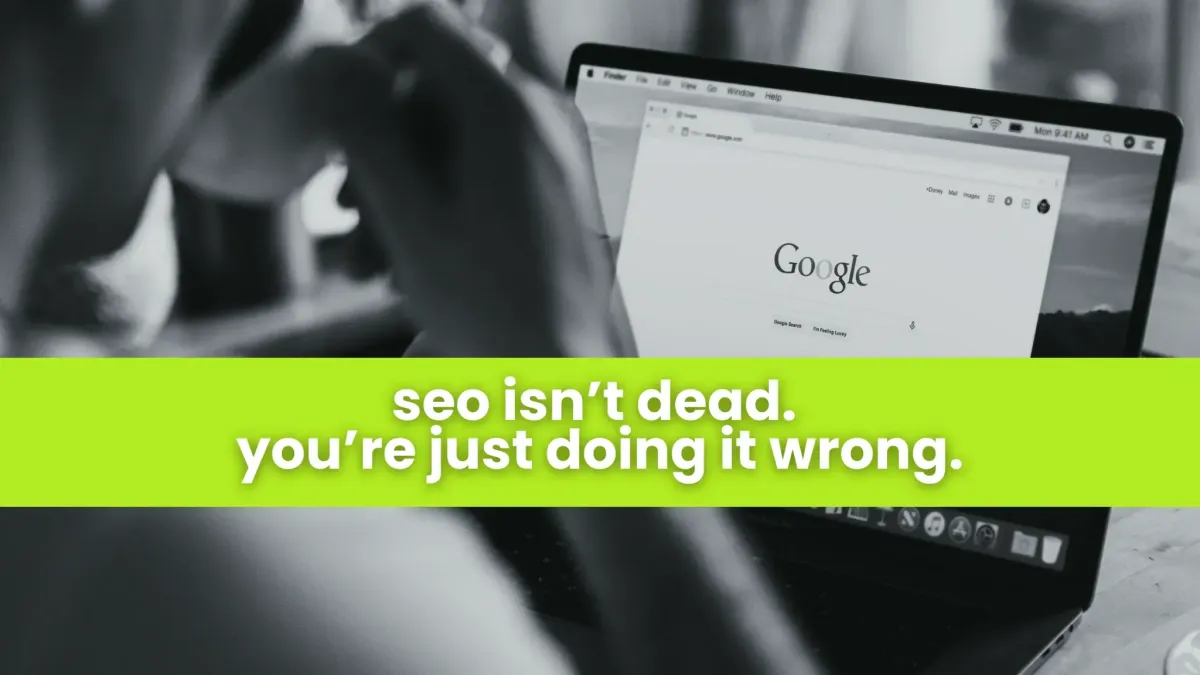
SEO Isn’t Dead, You’re Just Doing It Wrong.
There’s a lot of noise out there claiming that SEO is dead. The algorithm changed, social media took over, people don’t use blogs anymore.
Let’s set the record straight.
SEO is not dead, it just evolved. And if you’re still approaching it the way you did five years ago, it makes sense that your traffic feels like it dried up. But when done right, SEO is still one of the most powerful, affordable ways to get in front of the people who are already looking for you.
In this post, we’ll walk through what’s changed, what still works, and how to simplify your approach without getting overwhelmed by tech or trends.
1. Stop Creating Content That Doesn’t Have a Job
One of the biggest mistakes service-based businesses make is writing content just to check a box. You publish a blog or update your website because you feel like you should, but you’re not using keywords with intention, solving a real problem, or guiding someone to a next step.
If your content isn’t helping the right person find you and take action, Google won’t know what to do with it either.
What to do instead:
Start with a real question your ideal client might be typing into Google
Write a post or page that clearly answers that question in plain language
Make sure your headline and subheadings match what they’re searching for
Search engines prioritize content that is useful, direct, and aligned with what people actually need. The good news is, that’s also what your audience wants.
2. Your Google Business Profile Still Matters
This one’s especially important if you work locally or serve clients in specific regions, but even online service providers can benefit from a polished and up-to-date profile.
Google Business helps people find you fast, especially when they’re searching for services near them. It also adds credibility and gives potential clients a preview of your reviews, location, and contact info.
Make sure your profile includes:
Updated hours and business description
A booking link or contact method
Client photos and real testimonials
Relevant keywords in your service description
If you haven’t touched your listing in a while, now’s the time. Google favors profiles that stay active.
3. Keywords Still Matter, But Only If They’re Used Thoughtfully
Stuffing a page with repeated keywords won’t help. Google is smarter than that now. But that doesn’t mean keywords are irrelevant. You just need to use them the way a real person would search.
Here’s what works today:
Use specific, long-tail keywords like “SEO help for service businesses” instead of just “SEO”
Include keywords naturally in headlines, meta descriptions, and image alt text
Don’t forget about related terms your audience might use to describe the same problem
Tools like Ubersuggest, AnswerThePublic, or even Google’s autocomplete can help you discover what your people are actually searching for.
4. Your Site Experience Affects Your Ranking
Google doesn’t just rank based on keywords anymore. It pays attention to how people interact with your site. If visitors land on your homepage and bounce immediately, or if your pages load slowly, that’s a signal that something isn’t working.
To improve your SEO through user experience:
Make sure your site loads quickly, especially on mobile
Use clear navigation and a simple menu
Include obvious calls to action so people know what to do next
Avoid heavy pop-ups that block content or slow down the page
The easier your site is to use, the better it will perform.
5. Consistency Beats Volume
Posting once a week isn’t magic. Neither is posting every day. What matters more is staying consistent and building authority over time. Google wants to see that you’re actively maintaining your site, offering value, and building trust.
Even if you only post once a month, showing up with thoughtful, helpful content makes a difference.
Here’s what consistency looks like:
Regular updates to key service pages
One helpful blog post per month that answers a real question
Occasional refreshes to older posts or pages to keep content relevant
And remember, every piece of content should have a purpose. If it doesn’t help your ideal client or lead them to take the next step, it’s okay to let it go.
Final Thoughts
SEO isn’t what it used to be, but it’s still one of the most reliable ways to get discovered online. You don’t need to chase algorithms or turn your website into a content machine. You just need clarity, a little consistency, and a strategy that aligns with your real business goals.
At Unfiltered Marketing Group, we help service-based brands simplify their SEO so it works behind the scenes while they focus on what they do best.
